An active galactic nucleus (AGN) is a compact region at the center of a galaxy that emits a significant amount of energy across the electromagnetic spectrum, with characteristics indicating that the luminosity is not produced by stars. Such excess, non-stellar emissions have been observed in the radio, microwave, infrared, optical, ultra-violet, X-ray and gamma ray wavebands. A galaxy hosting an AGN is called an active galaxy. The non-stellar radiation from an AGN is theorized to result from the accretion of matter by a supermassive black hole at the center of its host galaxy.
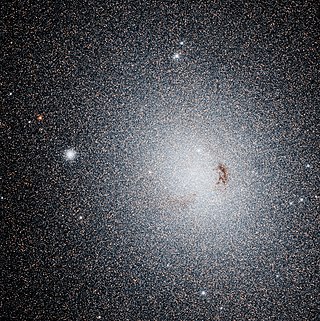
NGC 185 is a dwarf spheroidal galaxy located 2.08 million light-years from Earth, appearing in the constellation Cassiopeia. It is a member of the Local Group, and is a satellite of the Andromeda Galaxy (M31). NGC 185 was discovered by William Herschel on November 30, 1787, and he cataloged it "H II.707". John Herschel observed the object again in 1833 when he cataloged it as "h 35", and then in 1864 when he cataloged it as "GC 90" within his General Catalogue of Nebulae and Clusters. NGC 185 was first photographed between 1898 and 1900 by James Edward Keeler with the Crossley Reflector of Lick Observatory. Unlike most dwarf elliptical galaxies, NGC 185 contains young stellar clusters, and star formation proceeded at a low rate until the recent past. NGC 185 has an active galactic nucleus (AGN) and is usually classified as a type 2 Seyfert galaxy, though its status as a Seyfert is questioned. It is possibly the closest Seyfert galaxy to Earth, and is the only known Seyfert in the Local Group.

NGC 3227 is an intermediate spiral galaxy that is interacting with the dwarf elliptical galaxy NGC 3226. The two galaxies are one of several examples of a spiral with a dwarf elliptical companion that are listed in the Atlas of Peculiar Galaxies. Both galaxies may be found in the constellation Leo. It is a member of the NGC 3227 Group of galaxies, which is a member of the Leo II Groups, a series of galaxies and galaxy clusters strung out from the right edge of the Virgo Supercluster.
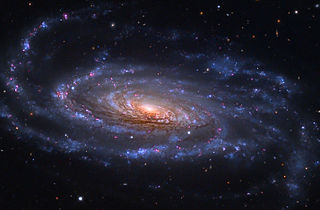
NGC 5033 is an inclined spiral galaxy located in the constellation Canes Venatici. Distance estimates vary from between 38 and 60 million light years from the Milky Way. The galaxy has a very bright nucleus and a relatively faint disk. Significant warping is visible in the southern half of the disk. The galaxy's relatively large angular size and relatively high surface brightness make it an object that can be viewed and imaged by amateur astronomers. The galaxy's location relatively near Earth and its active galactic nucleus make it a commonly studied object for professional astronomers.

3C 305, also known as IC 1065, is a Seyfert 2 radio galaxy located in the constellation Draco.

3C 61.1 is a Seyfert galaxy located in the constellation Cepheus.
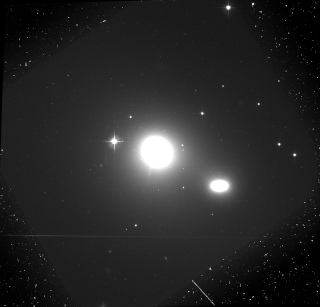
3C 66B is an elliptical Fanaroff and Riley class 1 radio galaxy located in the constellation Andromeda. With an estimated redshift of 0.021258, the galaxy is about 300 million light-years away.

3C 79 is a Seyfert Galaxy located in the constellation Aries. The extended emission-line region (EELR) is almost certainly photoionized by the hidden quasar.

3C 109 is a Seyfert galaxy located in the constellation Taurus.

3C 171 is a Seyfert galaxy located in the constellation Lynx.

3C 215 is a Seyfert galaxy/Quasar located in the constellation Cancer.
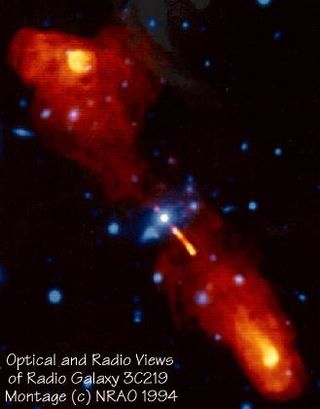
3C 219 is a Seyfert galaxy with a quasar-like appearance located in the constellation Ursa Major. This galaxy's radio jets are not detectable between the core and the outer radio lobes.

3C 223 is a Seyfert galaxy with a quasar-like appearance located in the constellation Leo Minor.

3C 249.1 is a Seyfert galaxy located in the constellation Draco.
3C 268.3 is a Seyfert galaxy/quasar located in the constellation Ursa Major.

3C 303 is a Seyfert galaxy with a quasar-like appearance located in the constellation Boötes.
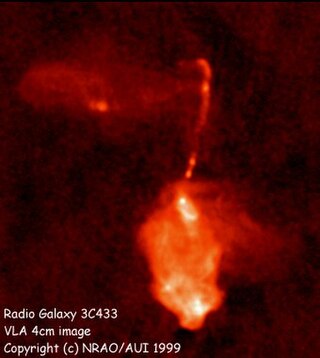
3C 433 is a Seyfert galaxy located in the constellation Vulpecula.

3C 438 is a Seyfert galaxy and Fanaroff and Riley class II radio galaxy located in the constellation Cygnus. The radio galaxy has two lobes and there is a radio jet leading to the south lobe, which also has a prominent double hot spot. There is age variation across the lobes.
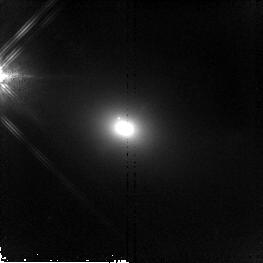
3C 452 is an elliptical galaxy about 1.2 billion light years away located in the constellation Lacerta. 3C 452 is a Seyfert galaxy and a Fanaroff–Riley class 2 radio galaxy, with the radiolobes extending for about 5 arcminutes, which at the distance of 3C 452 corresponds to about 450 kiloparsecs. Fainter radio lobes extend farther away, at megaparsec scales, probably created during a former period of elevated nuclear activity. Diffuse X-ray emission has been detected in the radio lobes.

3C 120, also known as Markarian 1506, is an active galaxy located in the constellation of Taurus, at a distance of about 420 million light years. It has been categorised as a type I Seyfert galaxy and a broad-line radio galaxy. 3C 120 has been found to be a variable source in all wavelengths and hosts a superluminal jet.


















